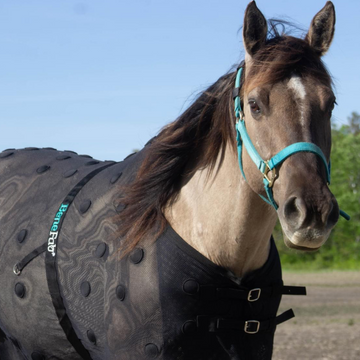Proud flesh is a common part of the wound healing process in horses, primarily when the wound occurs on the lower limbs. When a horse gets injured, its body starts to heal the wound naturally. Pink granulation tissue begins to form and fills the space between damaged tissues.
Typically, this tissue stops growing once the skin closes over the wound. However, when healing doesn’t go as planned, the granulation tissue continues to grow. It can eventually bulge above the skin surface, making it impossible for the new skin to grow over. This is called proud flesh.

Proud flesh can happen with any flesh wound, but is most common with injuries below the knees and hocks. These areas are prone to movement and have very little soft tissue cushioning the skin and bone. So as the horse moves, the wound edges are constantly being pulled, making it harder for the wound to close correctly.
This constant motion encourages granulation tissue to keep forming, often leading to the formation of proud flesh. Once proud flesh has started, it can be challenging to stop. Prevention is always best, but truly not always possible, depending on the location of the injury.
Treating Proud Flesh with the ABCs
While proud flesh is common in wound healing, treating wounds quickly and properly can reduce the chances of it occurring. One easy way to remember how to prevent it is with your ABCS:
Advice
Before doing anything, get your veterinarian’s input. They can examine the wound and decide if it needs stitches, antibiotics, or other treatment to help with healing. If you are unsure if a wound requires stitches, call your vet immediately and DO NOT apply anything to the wound before the vet arrives. This can interfere with their ability to treat the wound. Depending on the severity, your vet may suggest using antibiotics to prevent infection.
Bandage
Use a pressure wrap to keep the wound edges together. A properly applied bandage helps limit movement and protects the wound from further irritation. The pressure wrap also prevents debris and dirt from getting into the wound, which can increase the risk of infection. It's essential to change the bandage regularly to avoid moisture buildup. Your vet can instruct you on the correct way to bandage, depending on the location of the injury.
Clean & Covered
Keeping the wound as clean as possible is a must. Dirt, flies, and bacteria will slow healing and increase the risk of infection. A clean wound is far more likely to heal correctly, while a contaminated wound may stall healing altogether. Keep the wound covered with clean bandages to prevent any tearing or further injury.
Stall Rest
Keeping your horse calm and still is one of the best things when you are worried about proud flesh. Stall rest minimizes movement around the wound, which allows the skin to begin closing and helps reduce the risk of proud flesh. The less movement the wound experiences, the less chance the granulation tissue has to keep growing.
If proud flesh does develop, there are effective ways to treat it. A veterinarian can trim the excess tissue back to skin level. This gives the wound a fresh start and allows healing to continue. After trimming, another pressure bandage should be applied to help prevent the tissue from growing back. Sometimes, cortisone and an antibiotic can be applied directly to the wound to help shrink the tissue and protect from secondary infections.






















